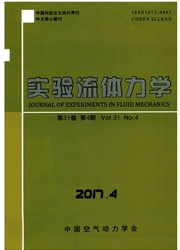

 中文摘要:
中文摘要:
结合激波风洞实验和数值模拟分析,对一种二元混压式进气道在实验中低单位雷诺数下反而呈现出自起动特征的异常现象进行了研究。根据激波风洞的反复实验观察,表明随着来流单位雷诺数的降低,在继进气道进入不起动状态之后又会重新出现自起动特征的异常起动现象。该结果与层流模型计算得到的流场结构相符,而与湍流模拟结果差异显著;分析表明,层流情况下,由于分离区向前体压缩面大范围地延伸,缓解了进气道入口的逆压梯度,从而在喉道处可以形成主体为超声速的通畅流道,而湍流情况下,进气道入口处激波/边界层干扰形成过分集中的分离泡则呈现明显的壅塞状态;尽管层流情况下进气道流场结构呈现出较为通畅的类似起动的特征,但其流量系数仍明显低于湍流的情况。因此,实验上所观察到的这种异常起动现象严格地说并不属于真正意义上的起动状态。
 英文摘要:
英文摘要:
With the help of combined experimental observation and numerical analysis,an in-vestigation is carried out on the unusual self-starting behaviors of a 2-D hypersonic inlet under low Reynolds number condition.Based on a series of repeated shock tunnel experiments,it is found that with a continuous decrease of the unit Reynolds number,an unexpected inlet self-starting configuration reappears after the unstarting process.The observation of the flow field a-grees fairly well with the results of the laminar simulation,but differs remarkably from the com-putational results obtained with turbulent model.The numerical simulations demonstrate that for laminar flow,a separation zone spreads out extensively to nearly entire forebody compression surface,which releases the high adverse pressure gradient and results in forming a supersonic path at the inlet throat.However,for turbulent flow,the separation can hardly reach far up-stream and consequently generates a strong concentrated separation bubble near the throat, which appears as an obviously choked and unstarting configuration.It needs to be emphasized that although the laminar inlet flow behaves with starting-like characteristics,the captured flow ratio is evidently lower than that of the choked turbulent flow under the same incoming flow con-dition.Therefore the so-called “unusual self-starting”inlet flow observed in the present study is not a true self-starting flow in reality.
 同期刊论文项目
同期刊论文项目
 同项目期刊论文
同项目期刊论文
 期刊信息
期刊信息
